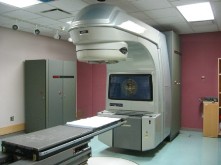The efficacy of RT in TED is controversial, in part because of different inclusion criteria and outcome analyses. A large series of retrospective studies have found RT reduces periocular inflammation in 60% of patients with active TED, similar to the success rate for oral GC. The benefit of prednisone tends to be more rapid, whereas for RT it is longer lasting. Prednisone combined with RT has greater benefit than treatment with prednisone alone.
Two randomized controlled studies from the Netherlands found that patients with TED treated with RT ultimately had better ocular excursions than patients treated with sham (no) RT.
The addition of RT to GC was shown to reduce the incidence of developing DON in high-risk progressive TED from 17% (GC alone) to 0% (GC and RT). In patients with established DON, the addition of RT to GC was shown to delay or reduce the need for decompression surgery compared with GC treatment alone. There is retrospective evidence that RT may prevent progressive expansion of muscles and recurrence of vision loss following successful orbital decompression.
Two randomized controlled studies have shown no benefit from RT. A study from Mayo comparing RT on one eye with sham therapy on the opposite side found no benefit in a composite outcome of proptosis, lid retraction, and soft tissue index. This study confirms that RT is ineffective in late or inactive disease, and it is understood that it has little benefit on either lid retraction or proptosis.
A recent study from the United Kingdom (CIRTED Trial) also found no benefit from the addition of RT to oral prednisone in subjects with active TED in terms of a binary composite clinical outcome score.
Modern linear accelerator radiotherapy units have an excellent safety record with retrospective series in TED showing no increased risk of cataract and only one report of a radiation induced tumor. Because of a small theoretical lifetime risk of developing tumors, its use for TED is contraindicated in people younger than 35 years.
RT may increase the incidence of retinal vascular disease in patients with diabetes mellitus (DM) or hypertension, and its use is often avoided in patients with DM. Orbital inflammation may increase during RT, but this can be controlled with concurrent GC.


